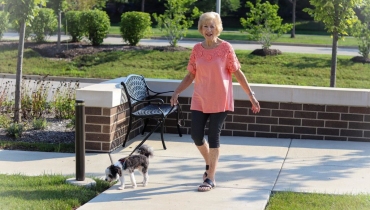Mobility is Our Goal
By: Alex Keown, Community Health Magazine

Dr. Shah discussing outpatient joint replacement surgery with his patient JoAnn.
For many patients, the idea of undergoing knee joint replacement surgery can be daunting, often due to concerns of a long recovery process. The anxiety of surgery coupled with recovery and limited mobility can outweigh the levels of pain associated with a damaged joint.
However, at Illinois Bone & Joint Institute (IBJI), extended recovery with limited mobility is a thing of the past. Patients who undergo joint replacement surgery are typically back on their feet after surgery and sent home the same day. Ritesh Shah, MD, hip and knee surgeon with IBJI, says the approach to surgery taken by the IBJI team has led to some remarkable results. When discussing total hip and knee replacements, Shah says patients are, on average, walking with assistance about 40 minutes after surgery, climbing stairs about 70 minutes after, and sent home about two hours later.
For more than four years, IBJI has been performing outpatient joint replacement surgeries and sending patients home sooner.
Outpatient Joint Replacement Surgery
Shah says the time between the patient climbing stairs and being sent home is among the fastest in the United States. Patient recovery has been swift, which is good for the health care system, as well as for the patients – they no longer have to miss out on many of life’s activities due to recovery. IBJI’s recovery process is not based on patient outliers – Shah says the results have been seen in hundreds of patients over the years.
JoAnn Murphy is one patient who benefitted from knee replacement surgery. Her right knee was replaced in November 2016. Six weeks later, she was walking two to three miles per day on a sandy Lake Michigan beach.
Months later, in February 2017, Murphy’s left knee was replaced. Within a month of surgery, she was walking even longer distances on the beach – four to five miles per day while maintaining a brisk pace.
“Neither my husband nor adult sons could keep up with me,” Murphy says.
Before her surgeries, she was in pain every night due to the degeneration in her knees. Now, she is pain-free. After her surgeries, Murphy didn’t need opioids or other pain killers – even though she says she has a low tolerance for pain.
Activities After Joint Replacement
Murphy has enjoyed her newfound freedom of walking pain-free. An avid golfer, she plays daily from May through October – and instead of using a cart, she walks 18 to 36 holes, six days per week.
“I have been able to travel and golf places I couldn’t before because walking the hilly courses was too painful,” she says. “But not anymore.”
In August 2018, Murphy traveled to Utah to go hiking in the mountains. She gave her new knees a workout during that trip, hiking up and down mountain trails. Murphy has become an unofficial spokesperson for IBJI, as well as for Dr. Shah. She has recommended the practice and its procedures to many friends who need joint replacement.
During her physical therapy sessions, Murphy spoke to other knee replacement patients, who went with a more traditional service and discovered that she was far ahead of them as a result of IBJI’s program.
“It is unbelievable how having my knees replaced has changed my life,” she says. “I tell everyone to do it now if you need it.”

Leading the Pack in Joint Replacement Surgery
Shah, along with foot and ankle surgeon Anand Vora, MD, credit IBJI’s surgery procedural system for the rapid recovery of patients. Vora, who specializes in ankle replacement surgery, points to the pre-operative education that they provide to their patients. The surgical teams explain the procedure to the patients ahead of time, informing them of the minimally invasive procedure used, as well as the importance of near-immediate movement following the surgery.
Shah and Vora say getting a patient on his or her feet within minutes of the surgery – 16 minutes is a record for Shah – provides several benefits. It allows patients to overcome any apprehension about movement following surgery; and, after a few minutes walking around, provides them with greater confidence. Shah says patients will quickly move from wondering what they cannot do to ‘what else can I do?’
“Early [movement] is huge and changes the outcome,” Shah says. “Mobility is our goal.”
At IBJI, there is a strong vertical integration of the team performing the procedure. From the start, the surgeon, anesthesiologist, nurse and physical therapists are all accountable for the patient’s well-being and post-surgery success.
Vora says the combination of good surgeons, good technique and the educational procedures that have become commonplace at IBJI have created a surgical model for outpatient joint replacement surgery that is being eyed by other groups across the country. He says there are orthopedic groups from other states that are learning from the IBJI model in order to benefit their patients.
“That’s what you want to hear about, how the procedures impact the lives of a patient,” Vora says.
Schedule online with a Knee Surgeon
Need to see a doctor for outpatient joint replacement surgery or knee treatment? Schedule online today with a knee surgeon—online or in-person—to learn more treatment options to get you back to feeling your best.
Schedule online with a Knee Surgeon
This article is part of the Ultimate Guide to Knee Pain Relief.





